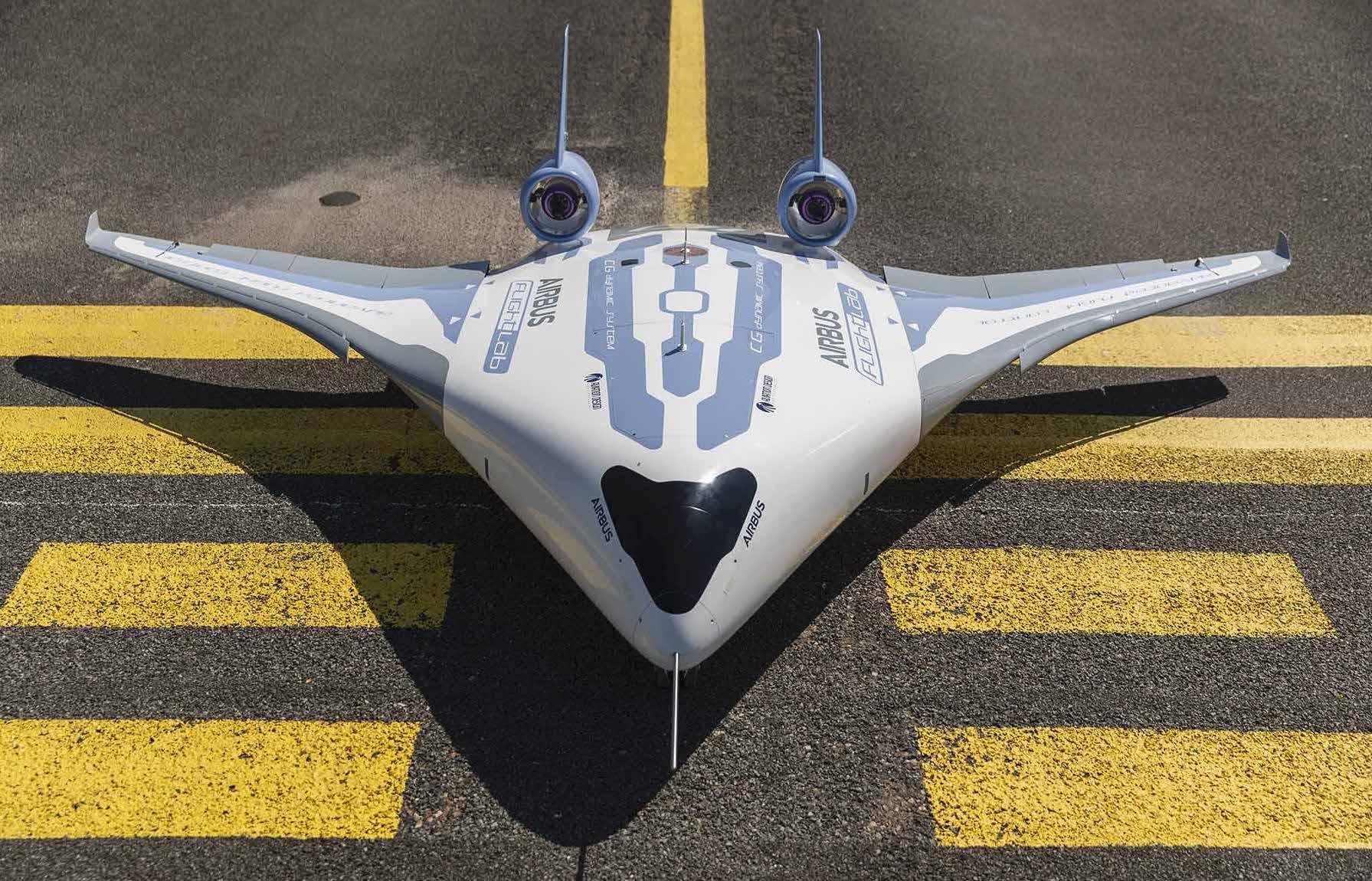Airbusが実証機ブレンデッドウィングボディを披露

脅威的な新機体形状が、将来の排出目標削減に対応できる数少ない方法の一つだと明らかになるにつれ、Airbusは、拡張性のあるブレンデッドウィングボディ(BWB)の技術実証を実施していることを明らかにしてきました。
全翼型であるBWBは、もともとMcDonnell Douglasによって、Boeingに買収される以前の1990年代に考案されました。胴体全体で揚力を発生させることができるため、運用効率改善の可能性を提供します。付加的な利点は、フォームドラッグの低減、および効率的な高バイパスエンジンやそれ以外の推進システム用に翼上に設置されたより大きなスペースがあります。
Airbusの実証機は、Maveric(革新的な制御を確立する検証・実験用模型航空機)と呼ばれ、全長6.5ft (約2m)、全幅10.5ft (約3.2m)あります。翼面積24.2ft²(約2.25㎡)の後部上に取り付けられた模型航空機用2軸ポッドタービンエンジンを搭載した同機は、フランス中部の某所で、2019年6月に初飛行を達成しました。Maveric はまだ飛行実験段階である、とAirbusの技術部門の副責任者であるJean-Brice Dumont氏は述べています。
特に、デルタ翼設計に適合した飛行制御システムを評価するよう設計されると、飛行実験は研究の第二段階へと続き、安全性や製造性、空港の互換性、整備、サポートなど、より幅広い観点からこの型を評価します。Dumont氏は次のように述べます。「我が社はこれを一つの選択肢として研究する必要がある。」「すでに多くのことが分かってきた。そして、実験によって、実際の飛行状況における、このような型の飛行行動を理解することができた。今までのところ、我が社は、それを明らかにする理由であるゴーサインを有している。そして幅広く研究を続けている。」
Airbusの見解によると、初期の単通路型機のBWBは、現在の主翼部と胴体が別の設計に比べて、燃料消費を最大20%減少させる可能性があります。Boeingと最近ではLockheed Martinが20年以上に渡る研究の結果、軍用機と貨物機に、一体型設計を目標にしてきたにもかかわらず、最近の技術進歩によってその設計は短中期的に見て、より魅力的になっている、とAirbusは述べています。「今、BWBをどんな風に復活させたいか。いくつかの技術が改良されてきた。機体をより軽くし、飛行制御とコンピューター機能のレベルを一つ上げることができた。つまり、それまでに比べて、少なくともより高次のレベルで課題に立ち向かうことができる。」
しかし、Dumont氏によると、実際の原動力は航空産業が直面している環境問題です。「直面しているプレッシャーと、2050年に排出目標の到達を中断しなければならないという現実によって、我が社は、それ以前は下ることのなかった道を走らなければならない。以上のことから解決が難しいと今は考えている。」さらに、BWB型は特に魅力的である。なぜなら、非従来型のハイブリッド電動システムと、おそらく最終的には、全電動推進システムをより簡単にサポートできるから、とDumont氏は付け加えます。
Airbusによると、Mavericは広範な先端技術研究グループの一部を担い、将来の製品開発の可能性を導くことができるでしょう。昨年発表された分散型推進実証プログラムであるEcoPulseなど、これらのプロジェクトのいくつかは、これまでより大型スケールの実証機で技術テストを実施するという決定に影響を及ぼします。Dumont氏は次のように述べます。「考えをさらに深めるために、「Scale 1」あるいはより大型の実証機を飛ばす必要がある。しかし、その前に、空港のインターフェース上の問題と推進システムに関する問題に答えなければならない。」
「BWBに最適なものは何か。現在、2基のポッドエンジンがある。しかしそれは正しいフォーミュラなのか。並行して、フランスのDaherとSafranと共に、EcoPulseをテストしている。それは、分散型推進用の飛行制御と出力制御をいち早く教えてくれる。そのため、これを潜在的な製品にまとめている。次の段階は、もっと大きなスケールでこれを飛ばすことである。しかし、正確にはどのくらいのスケールでいつ飛ばすか、まだ決まっていない。」
EcoPulseプロジェクトの下で、DaherとAirbus、Safraは、2022年半ばまでに、分散型推進実験として、TBM 900の改良したターボプロップエンジンを飛ばす計画をしています。同機は標準のノーズセクションエンジンとプロペラを備えているにもかかわらず、TBMは各翼に3枚羽根のプロペラを備えた機体に改良されます。各機は、バッテリーやAPUから供給される、Safranの電動モーターである45キロワットのENGINeUSで動きます。Airbusはバッテリー技術と飛行力学に貢献しています。
重要な問題は、BWB型の一般に窓のないキャビンが乗客にとって魅力的かどうかです。Boeingが長年続けてきたBWB型の研究は、そのいくつかはNASAと共同でX-48プロジェクトの下で行われてきましたが、もっぱら飛行特性に重点を置いています。しかし、多くの潜在的な乗客と貨物機型の評価も含んでいます。これらの大部分は、乗客の受け入れと安全性の懸念に関連する問題ゆえに、乗客の役割よりも優先されてきました。しかしAirbusは、状況把握用のバーチャルスクリーンを含む技術上のコンセプトによって、一般の旅行客がBWB型を受け入れやすくなると考えています。
「我が社は困難な選択肢を伴わなければならない。そして、できるだけ早い時期にサービスを導入し、2050年までに利益を得る必要がある。一刻の猶予もない」、とDumont氏は述べています。
シンガポール・エアショーの詳細は、こちらからご覧になれます。
As it becomes clearer that disruptive new airliner configurations will be one of the few ways of meeting the reduced emissions targets of the future, Airbus has revealed it is flight-testing a scaled blended wing body (BWB) technology demonstrator.
The BWB flying wing configuration, originally conceived by McDonnell Douglas in the 1990s prior to its acquisition by Boeing, offers potential operating efficiency improvements because lift can be generated across the fuselage. Additional benefits include reduced form drag and greater space above the wing for more efficient higher bypass engines or other propulsion systems.
Dubbed the Maveric (model aircraft for validation and experimentation of robust innovative controls), the Airbus demonstrator is 6.5 ft. long with a 10.5 ft-span wing. Powered by twin podded model aircraft turbine engines mounted above the aft deck of the 24.2 sq. ft area wing, the aircraft first flew in June 2019 at an undisclosed location in central France. Maveric is still being flight tested says Jean-Brice Dumont, executive vice president of engineering for Airbus.
Designed specifically to evaluate flight control systems adapted for delta wing designs, the flight tests will be followed by a second round of studies to evaluate wider aspects of the configuration including safety, manufacturability, airport compatibility, maintenance and support. “Let’s be clear we are studying this as an option,” says Dumont. “We have already learned a lot and tests have helped us understand the flight behaviour of this kind of configuration in a real flight condition. So far we have a green light which is why are unveiling it, and we are continuing with a more extensive study.”
Airbus believes an initial single-aisle sized BWB could potentially provide up to 20% lower fuel burn than current tube-and-wing designs. Although Boeing, and latterly Lockheed Martin, have targeted blended designs at military and cargo roles after more than two decades of research, Airbus says recent technology advances could make it more attractive in the near to mid-term. “What makes us wish to revive the BWB now? Some technologies have improved; we can make the aircraft lighter and our flight controls and computing capabilities are one level higher. That means we can face the challenges at least a level higher than before.”
However, Dumont says the real driver is the environmental concerns facing the industry. “The pressure we are under and the fact we need to disrupt to reach emissions objectives in 2050 forces us to drive down avenues we wouldn’t have gone down earlier. That’s because the equation was not resolvable and now we believe it is.” Dumont adds BWB configurations are also particularly attractive because they can more easily support non-conventional hybrid electric and, perhaps ultimately, all-electric propulsion systems.
Airbus says the Maveric forms part of a broader group of advanced technology studies which will help guide potential future product development. Some of these projects, including the EcoPulse distributed propulsion demonstrator unveiled last year, will influence decisions on which technology may be tested in a larger scale demonstrator. “To take this concept further we will need to fly a ‘Scale 1’ or larger demonstrator, but before that, we must answer questions about airport interface issues and the propulsion system,” says Dumont.
“What’s the best fit for the BWB? Right now we have two podded engines but is it the right formula? In parallel, we are testing the EcoPulse with Daher and Safran in France which is teaching us quickly about flight controls and power controls for distributed propulsion. So, we are converging this into a potential product. I’d say the next step would be flying this at a larger scale, but at exactly what scale and when I don’t know.”
Under the EcoPulse project Daher, Airbus and Safran plan to fly a modified TBM 900 turboprop as a distributed propulsion demonstrator by mid-2022. Although the aircraft will retain its standard nose-section engine and propeller the TBM will be modified with three small propellers on each wing. Each will be driven by a 45-kW Safran ENGINeUS electric motor, fed by batteries or an APU. Airbus is contributing battery technology and aerodynamic modelling.
One key question is whether the generally windowless cabin of a BWB can be made attractive to passengers. Boeing’s long-running BWB studies, some of which were conducted with NASA under the X-48 project, focused mostly on flight characteristics but also included many potential passenger and cargo configuration evaluations. The majority of these favoured freight over passenger roles due to issues associated with passenger acceptance and safety concerns, but Airbus believes technology concepts that include virtual screens for situational awareness could make BWBs acceptable to the traveling public.
“We need to come with disruptive options and enter service at the earliest possible date to bring benefits by 2050. The clock is ticking,” says Dumont.